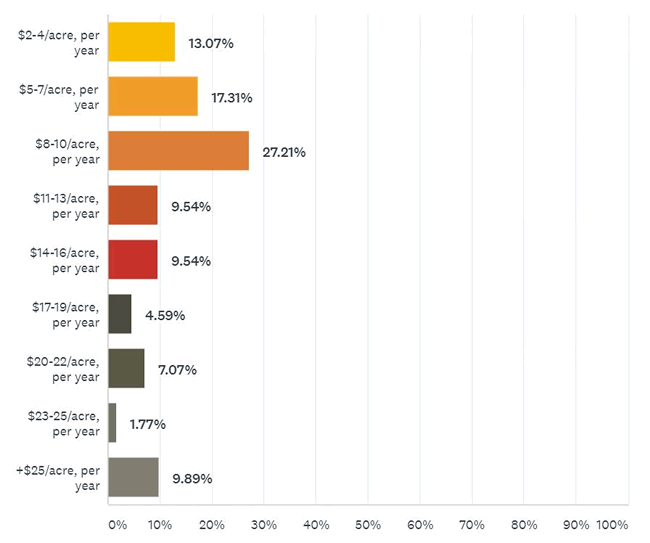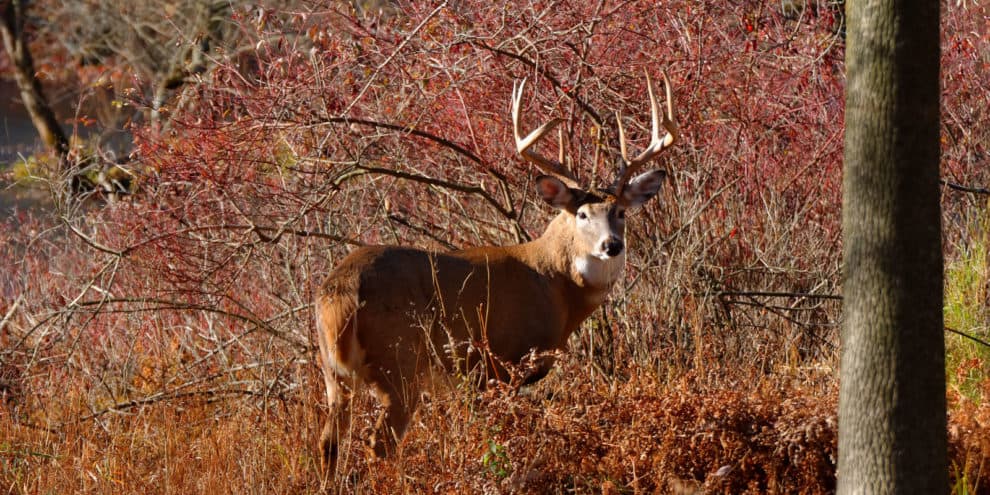Last month, the LANDTHINK Pulse posed the following question to our audience: In your opinion, what is a fair price to pay for leasing good hunting land?
Our informal online survey revealed that 27.21% of respondents think that $8-10/acre, per year, is a fair price to pay for a good piece of hunting ground. Land is one thing all hunters have in common, yet securing a quality piece of land can be the most challenging part of hunting. The majority of hunting in the U.S. is done on public land, and while hunting public land can be quite good in some parts of the country, it often brings a lot of frustration. Not only is public land becoming less abundant, but on public land hunters are forced to deal with hikers & backpackers, conservation officers, safety concerns, and worst of all- overcrowding. Nothing is worse than spending time scouting out a great spot for opening day, only to discover someone beat you there and placed their stand a few yards away. Every year, more and more disenchanted hunters are seeking out hunting land to lease or buy.
Simply put, a hunting lease is an agreement between a private landowner and a hunter; a hunter pays a landowner for the right to hunt on his or her land, and the duration and provisions are spelled out in a tightly-written contract. The number of sportsmen leasing hunting land is rapidly increasing. Fewer people can afford to buy raw land, and it’s pushing more hunters into the lease market. Some are willing to pay big bucks for a lease on a small parcel of land in those high-demand areas that consistently produce mature bucks. There are many factors that have an effect on the price of a hunting lease besides demand and deer quality, like accessibility, property amenities, management services, as well as neighboring properties.
Leasing hunting land comes with certain advantages:
- Less costly when compared to owning (no down payment, monthly payments, property taxes, or maintenance)
- Hunters typically gain access to more quality ground
- Having the property to yourself (unlike public land) assures hunting success
- Provides a fair chase hunting experience
- If you discover you don’t like the land, just find another property when the lease agreement ends
- Cost of the lease can be divided among family and friends
Leasing hunting land can be a rewarding experience. It allows hunters to reap the benefits of ownership without taking on the risk that comes with ownership.
The LANDTHINK audience certainly expressed mixed views on what they consider to be a fair yearly rate for a great piece of land to hunt on. The results were all over the board, but the largest percentage (27.21%) indicated that $8-10/acre was a fair price to pay yearly to lease quality hunting property, followed by 17.31% of our audience, who indicated that $5-7/acre was a fair price. Only 1.77% said they considered a lease rate of $23-25/acre to be fair.
Hunters that are looking for the perfect piece of land to lease should talk to a local land agent, who is prepared to discuss with them the factors that need to be considered before signing a lease agreement. Land agents can assist hunters in analyzing aerial maps of the property as well as the adjacent properties, to help determine deer movement/travel patterns when the hunting pressure is on. Land agents will also walk the property with you, checking out the lay of the land, scrapes and rubs, property boundaries, wind directions, and hunting stand locations.
Most any hunter will tell you- if you can, buy. Nothing is better than owning your own land and having the ability to do anything you want anytime you want, extending to recreational activities beyond hunting.
In his recent LANDTHINK article How to Buy Land for the Cost of a Hunt Lease, Daniel Hautamaki, land agent with Southeastern Land Group, provides a scenario that might make some hunters reconsider leasing. Daniel provided a real-life example of a friend that recently bought some land whose annual mortgage payments are almost equal to what he would have spent annually on a lease. “The key to making this method work is simple: spread the cost of the land over a few people.” By getting a few friends in on the purchase, they’d each end up spending about what it would cost if they leased individually every year. “The trade-off would be that they would have to share the property, but instead of throwing money away on a lease they would be building equity in a land investment. And they could spread the load of improving the property among the four of them.” Anyone interested in pursuing this purchase method should talk to a land agent and secure the services of an attorney to create a legal structure that protects everyone involved.
Here’s how the survey results panned out:

- 27.21% said $8-10/acre, per year, was a fair price
- 17.31% said $5-7/acre, per year, was a fair price
- 13.07% said $2-4/acre, per year, was a fair price
- 9.89% said +$25/acre, per year, was a fair price
- 9.54% said $11-13/acre, per year, was a fair price
- 9.54% said $14-16/acre, per year, was a fair price
- 7.07% said $20-22/acre, per year, was a fair price
- 4.59% said $17-19/acre, per year, was a fair price
- 1.77% said $23-25/acre, per year, was a fair price
Thank you to everyone who participated and shared the Pulse with friends and connections in the land industry. LANDTHINK would like to extend a big thank thank you to RANCHFLIP for sponsoring the October Pulse. RANCHFLIP is part of the LANDFLIP NETWORK and is devoted to ranchland for sale, including cattle ranches, horse ranches, hunting ranches, recreational ranches, ranchettes for sale, and more.
LANDTHINK is seeking a sponsor for the December LANDTHINK Pulse and months thereafter. The holiday season has arrived and people are spending more time online. There’s no better time than now for land brokerages to sponsor the Pulse question and get noticed by buyers and sellers. You’ll get insane exposure on Social + Email + Web. That’s 500,000+ monthly eyes on you! Pulse sponsorships are offered on a first come first serve basis and are subject to certain limitations. If your business would be interested in sponsoring next month’s December Pulse question, please contact us soon.
Do you have a suggestion for next month’s Pulse question? Submit your question and we might choose yours!
We want to know what you think about our November Pulse question, sponsored by LANDFLIP: Do you think excessive logging & thinning of forests helps to prevent wildfires? Answer now.
This content may not be used or reproduced in any manner whatsoever, in part or in whole, without written permission of LANDTHINK. Use of this content without permission is a violation of federal copyright law. The articles, posts, comments, opinions and information provided by LANDTHINK are for informational and research purposes only and DOES NOT substitute or coincide with the advice of an attorney, accountant, real estate broker or any other licensed real estate professional. LANDTHINK strongly advises visitors and readers to seek their own professional guidance and advice related to buying, investing in or selling real estate.










Add Comment